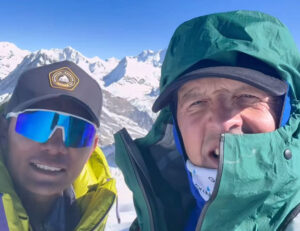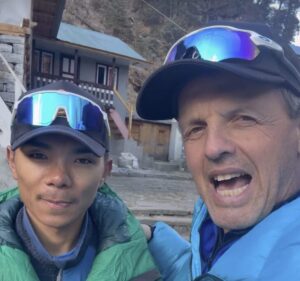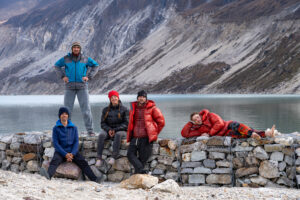A full retreat took place after more avalanches swept Manaslu’s route and Base Camp yesterday, killing one man, Dawa Chhiring. Some climbers said that they turned around “out of respect” for the lost Sherpa, but the expedition leaders rather point to dangerous conditions and no prospect of improvement.
All remaining companies have accepted the inevitable. Conditions are simply too dangerous. Getting clients or staff up the route is nearly suicidal. Comments on social media had become increasingly critical toward those still trying to summit.
Dawa Chhiring’s group, led by Arnold Coster, had canceled their summit push because of the avalanche danger and were retreating when the fatal accident occurred.
“Dawa was descending with our team from C3,” a devastated Arnold Coster reported. “Between C2 and C1, Dawa led the way to break the trail until an avalanche hit. When [it] cleared, two Sherpas from another team were still attached to the rope, but Dawa was gone.”
Dawa Chhiring’s body found
Coster confirmed that they searched for him since yesterday. First, they only found the other affected Sherpas’ backpacks. Finally, Gelje Sherpa and Gesman Tamang, who were searching on foot, found his body in a crevasse. Both had been close friends of Dawa Chhiring.

Dawa Chhiring, aka. DC Sherpa, on winter Manaslu last year. Photo: Instagram
“He was a loving father and one of the best people I’ve ever met,” Sophie Lenaerts said. She climbed Everest and attempted winter Manaslu with Dawa Chhiring last year.
Ralf Dujmovits said that at least one helicopter performed a longline rescue this morning, while it searched for Dawa Chhiring’s body. Dujmovits tried to reach Manaslu’s true summit three times this season. Each time, high winds or dangerous snow conditions forced him back, he told Stefan Nestler. Dujmovits climbed Manaslu in 2007 but hadn’t realized at the time that he had only reached the foresummit. This was to have corrected that oversight.
Final Manaslu summits occurred on October 1. Since then, everyone has aborted. We are now waiting for confirmation that all climbers who were in Camp 3 this morning have safely made it down. Gesman Tamang and his client retreated from Camp 3 to Camp 2 and were airlifted from that point, in order to avoid the most dangerous sections. Others may have used that method as well.
As an aside: Billi Bierling wants to remind those who summited to send their photos and details to The Himalayan Database. They can register their expeditions and upload their reports here.
Untamed
Manaslu has shown that 8,000m peaks cannot be tamed, despite uneventful climbs (and excellent weather) on K2 this summer, on Annapurna in 2021, and on Kangchenjunga last spring. These experiences led many clients to believe that with enough fixed ropes and support, there was no such thing as a difficult mountain. On Manaslu, weeks of bad weather, avalanches, and fatal accidents have shattered those notions.

Climbers move through the area that avalanched on September 26. Photo: Viridiana Alvarez
“This has taught me how dangerous this mountaineering world really is,” Adrianna Brownlee wrote back in Base Camp. “Pro mountaineers and Sherpas have passed away this season on a mountain many of us [thought] would be a nice climb.
“I pray that I will never have to come face to face with an expedition like this again,” the 21-year-old Brownlee added. “It has certainly left many thoughts to ponder and process over the next few weeks.”
Helicopters more and more vital

Pasang Rinzee directs pilot Simone Moro during a rescue in a higher camp some days ago on Manaslu. Photo: Abiral Rai
Other climbers are now sharing stories of rescues. Chris Warner, climbing with Imagine Nepal, was on his summit push when Chhiring Sherpa, who has supported him on several expeditions, suddenly felt ill. The two of them had a difficult retreat to Camp 2, where Warner cared for Chhiring through the night until a helicopter airlifted them out the following morning.
Warner’s report reminds us that this season, helicopters flew almost daily in very difficult conditions to airlift injured or sick climbers from the higher camps. Without them, especially after the September 26 avalanche, the death toll would have been higher.
Over on Dhaulagiri too
Dhaulagiri has also closed for the season. No one made it above Camp 3. Bad weather and avalanche conditions forced all climbers down. Even Mike Arnold, Mathieu Maynadier, Vivian Bruchez, Matheo Jacquemond, and photographer Bertrand Delapierre are back in Kathmandu and heading home. The team had eyed a first complete ski descent of Dhaulagiri.

A rainy puja day some weeks ago on Dhaulagiri. Photo: Mathieu Maynadier
Everest: Bargiel also aborts
The weather will also be bad on Everest for the foreseeable future, with heavy snowfall and strong winds. This prompted Andrzej Bargiel to cancel his attempt to climb and ski down Everest without bottled oxygen.
And now what?
While commercial teams are done on Manaslu and Dhaulagiri, independent climbers may continue to wait for better conditions. Fall permits are valid throughout October. They would have the mountain to themselves. Yet trails will be buried, and at least some fixed ropes are missing. It will be a purer but more challenging experience.
Guides and outfitters are now moving to other peaks, especially Ama Dablam. Here, teams will come and go throughout October and November. Imagine Nepal also has a team on Himlung, and Pioneer Adventure is already working on the new route they hope to open on Cho Oyu’s Nepal side.
Pioneer is bringing clients to help subsidize the experiment. At least one of them, Csaba Varga of Hungary, has reached Base Camp and intends to head for Camp 1 as soon as possible.
Gelje Sherpa has confirmed that he’ll be on Cho Oyu too, but he has not yet said who he will climb with or by which route. Last winter, he led a team on a separate line from Pioneer’s.






